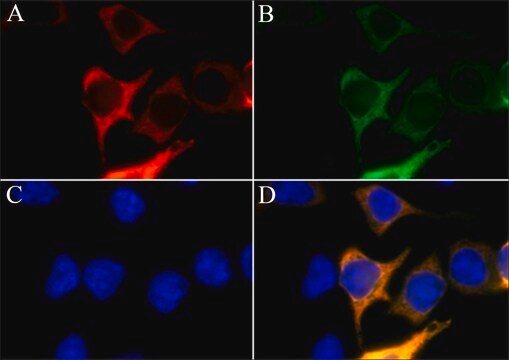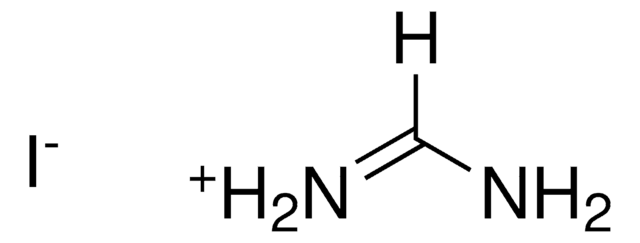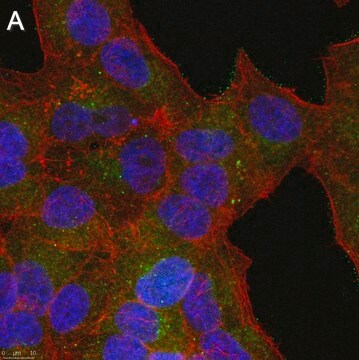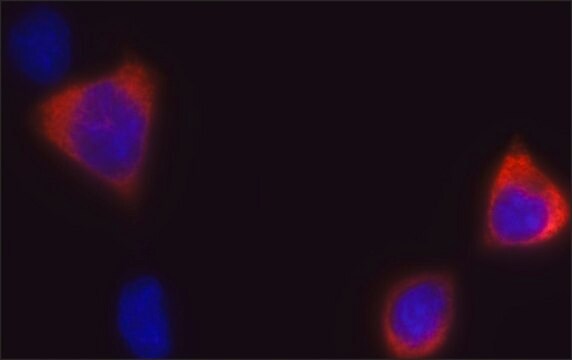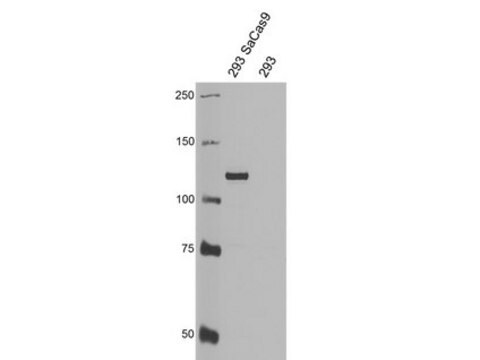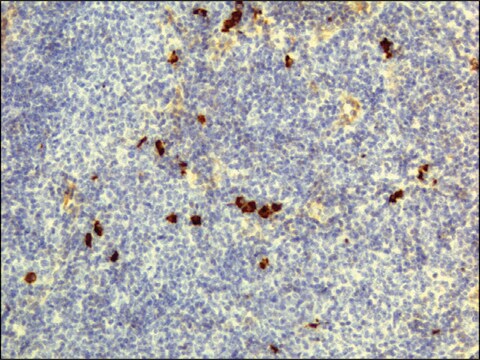SAB4200777
Anti-LbCas12a (Cpf1) antibody, Mouse monoclonal
clone LbCpf1, purified from hybridoma cell culture
Sinónimos:
Anti-CRISPR-associated endonuclease AsCas12a from Lachnospiraceae bacterium ND2006, Anti-LbCpf1 antibody, Mouse monoclonal
About This Item
Productos recomendados
origen biológico
mouse
Nivel de calidad
forma del anticuerpo
purified from hybridoma cell culture
tipo de anticuerpo
primary antibodies
clon
LbCpf1, monoclonal
Formulario
buffered aqueous solution
mol peso
~135 kDa
concentración
~1.0 mg/mL
técnicas
immunoblotting: 0.6-1.2 μg/mL using human HEK-293T cells over-expressing LbCpf1 protein
immunofluorescence: 0.25-0.5 μg/mL using human HEK-293T cells over-expressing LbCpf1 protein
immunoprecipitation (IP): 1-2.5 μg/test using lysate of human HEK-293T cells over-expressing LbCpf1 protein
isotipo
IgG1
Nº de acceso UniProt
Condiciones de envío
dry ice
temp. de almacenamiento
−20°C
modificación del objetivo postraduccional
unmodified
Descripción general
Cpf1 (CRISPR from Prevotella and Francisella 1) belongs to class 2 type V CRISPR-Cas endonuclease system. Cpf1 comprise several differences from Cas9 protein including cleavage with 5′ overhangs, a shorter guide RNA and a longer distance between the seed sequence and cleavage site.
LbCpf1, Cpf1 from Lachnospiraceae bacterium ND2006, was examined together with 15 members of Cpf1 nuclease family and proved to mediate efficient genome editing in HEK293FT cells with improved results compared to SpCas9.5 According to thr crystal structure, LbCpf1 has a triangle-shaped architecture with a large positively charged channel at the centre.7 The crRNA binding was shown to induce the pronounced structural rearrangements of LbCpf1, leading to formation of a substrate-binding conformation of LbCpf1. Over-expressed in plant cells, LbCpf1 demonstrated more than 10-fold transcriptional repression of the target gene.
Monoclonal anti-LbCpf1 antibody can provide a useful tool for genome editing research, such as detecting and monitoring LbCpf1 positively transfected cells.
Inmunógeno
Aplicación
Forma física
Almacenamiento y estabilidad
Otras notas
In order to obtain best results in different techniques and preparations we recommend determining optimal working concentration by titration test.
¿No encuentra el producto adecuado?
Pruebe nuestro Herramienta de selección de productos.
Código de clase de almacenamiento
12 - Non Combustible Liquids
Clase de riesgo para el agua (WGK)
nwg
Punto de inflamabilidad (°F)
Not applicable
Punto de inflamabilidad (°C)
Not applicable
Listados normativos
Los listados normativos se proporcionan para los productos químicos principalmente. Para los productos no químicos sólo se puede proporcionar información limitada. Si no hay ninguna entrada, significa que ninguno de los componentes está en la lista. Es obligación del usuario garantizar el uso seguro y legal del producto.
EU REACH Annex XVII (Restriction List)
Elija entre una de las versiones más recientes:
Certificados de análisis (COA)
¿No ve la versión correcta?
Si necesita una versión concreta, puede buscar un certificado específico por el número de lote.
¿Ya tiene este producto?
Encuentre la documentación para los productos que ha comprado recientemente en la Biblioteca de documentos.
Nuestro equipo de científicos tiene experiencia en todas las áreas de investigación: Ciencias de la vida, Ciencia de los materiales, Síntesis química, Cromatografía, Analítica y muchas otras.
Póngase en contacto con el Servicio técnico